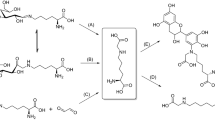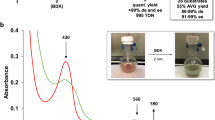Abstract
Carboxyl groups of HbS are readily activated by water-soluble carbodiimide atpH 6.0 and room temperature. These o-acylurea intermediates (activated carboxyl) are accessible for nucleophilic attack by amines. With glycine ethyl ester, the amidation is very selective for the γ-carboxyl of Glu-43(β) and more than 65% of the glycine ethyl ester incorporated is on this carboxyl group. In contrast, glucosamine derivatizes the γ-carboxyl group of Glu-22(β) as well as that of Glu-43(β) to nearly the same degree. However, the total amidation of HbS by glucosamine is lower than that with glycine ethyl ester. The differential selectivity of the two amines is apparently related to the differences in the microenvironment of the γ-carboxyl groups of Glu-22(β) and Glu-43(β), which either facilitates or refracts the aminolysis of the activated carboxyl with the two amines to different degrees. The carboxyl groups of isolated β-chain exhibit a higher reactivity for amidation with glycine ethyl ester than does the tetramer. The carboxyl groups of Glu-22(β) and Glu-43(β) and that of Asp-47(β) are all activated by carbodiimide suggesting that the higherpKa of these carboxyl groups (facilitating the activation) is a property of tertiary interaction of the polypeptide chain. The interaction of the β-chain with α-chain, i.e., generation of the quaternary interactions, reduces overall reactivity of the carboxyl groups of the protein. The higher selectivity of hemoglobin S for amidation at Glu-43(β) with glycine ethyl ester compared with that of isolated β-chain appears to be primarily a consequence of decreased amidation at sites other than at Glu-43(β).
Similar content being viewed by others
References
Acharya, A. S., and Manning, J. M. (1980).J. Biol. Chem. 255, 1406–1412.
Acharya, A. S., and Seetharam, R. (1985).Biochemistry 24, 4885–4890.
Bucci, E., and Fronticelli, C. (1964).J. Biol. Chem. 240, 551–552.
Dickerson, R. E., and Geis, I. (1983).Hemoglobin Structure, Function, Evolution and Pathology, Benjamin/Cummings, Menlo Park, California.
Edelstein, S. J. (1981).J. Mol. Biol. 150, 557–575.
Fermi, G., and Perutz, M. F. (1981). inHemoglobin and Myoglobin. Atlas of Molecular Structure in Biology (Phillips, D. C., and Richards, F. M., eds.), Clarendon Press, Oxford, pp. 101–102.
Hoare, D. G., and Koshland, D. E., Jr. (1967).J. Biol. Chem. 242, 2447–2453.
Ingram, V. M. (1956).Nature (Lond.)178, 792–794.
Love, W. E., Fitzgerald, P. M. O., Hanson, J. C., Roger, W. E., Jr., and Ringle, W. M. (1978). inBiochemical and Clinical Aspects of Hemoglobin Abnormalities (Caughey, W. S., ed.), Academic Press, New York, pp. 165–170.
Love, W. E., Fitzgerald, P. M. O., Hanson, J. C., and Roger, W. E., Jr. (1979). INSERM Symp.9, 65–71.
Padlan, E. A., and Love, W. E. (1985).J. Biol. Chem. 260, 8280–8291.
Seetharam, R., Manning, J. M., and Acharya, A. S. (1983).J. Biol. Chem. 258, 14810–14815.
Wishner, B. C., Ward, K. B., Lattman, E. E., and Love, W. E. (1975).J. Mol. Biol. 98, 179–194.
Author information
Authors and Affiliations
Rights and permissions
About this article
Cite this article
Acharya, A.S., Khandke, L. Selective amidation of carboxyl groups of the intermolecular contact regions of hemoglobin S: Structural aspects. J Protein Chem 8, 231–237 (1989). https://doi.org/10.1007/BF01024946
Received:
Published:
Issue Date:
DOI: https://doi.org/10.1007/BF01024946




